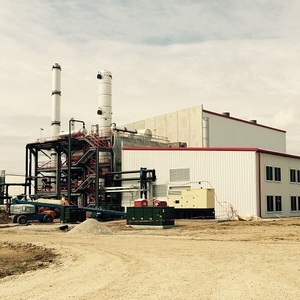California ethanol mill to build novel biodiesel refinery on-site

Photo: Jatrodiesel Inc.
April 5, 2017
BY Ron Kotrba
A California ethanol plant is being awarded a grant from the state energy commission to help build a biodiesel production facility on-site. Calgren Renewable Fuels, an ethanol refinery in Pixley, California—the heart of dairy country—already features a recently constructed anaerobic digester that powers the facility’s 57 MMgy of ethanol production, and now the integrated biorefinery plans to diversify even further by adding a unique biodiesel technology to its renewable energy repertoire.
Calgren Renewable Fuels received a notice of proposed award for $3.6 million from the California Energy Commission’s Alternative and Renewable Fuel and Vehicle Technology Program. The award would require $4.9 million in match funding. The funds will be used to construct a supercritical biodiesel plant on-site engineered and built by Jatrodiesel Inc., similar to the first commercial Super plant Jatrodiesel installed at the Patriot Renewable Fuels ethanol plant in Annawan, Illinois, now owned by Cenex Harvest States.
“We’ve been talking with Jatrodiesel for a long time and following their progress,” said Lyle Schlyer, president of Calgren Renewable Fuels. “Jatrodiesel constructed its first Super plant at the former Patriot ethanol plant, and my sense is they thought they would be able to use that as more of a showcase. We’re certainly willing to let them use our facility in that way.”
Advertisement
Advertisement
On-site preliminary engineering has been underway for some time, Schlyer said. “We’ve had a heck of a start,” he said, adding that Calgren Renewable Fuels has hired a project manager and procurement of equipment will begin in the next few weeks. “Some of the items have long lead times, especially the reaction vessels and specialized pumps.”
Jatrodiesel describes its Super technology as a single-stage process that eliminates esterification and transesterification, and puts no limit on free fatty acid (FFA) levels in feedstock. According to the company, the process cuts the cost of traditional biodiesel refining by 25 to 28 percent, in part by eliminating the need for conventional catalysts. Feedstock is mixed with methanol and is introduced into the Super column, which operates in a supercritical environment. High temperatures and pressures are maintained in a continuous process and conversion occurs in minutes with minimal yield loss. Water content also has no effect on the process. The mixture coming from the Super column is then sent through separation to isolate biodiesel from glycerin, and the excess methanol is recovered. The biodiesel is then either water- or dry-washed to remove excess glycerin.
Advertisement
Advertisement
The facility will be able to produce more than 5 MMgy of biodiesel from high-FFA feedstock, including distillers corn oil produced on-site from Calgren Renewable Fuels’ ethanol process, along with brown grease, acid oils and other low-cost feedstock transported from off-site. “A lot of biodiesel producers don’t want high-FFA feedstock, but for us, we’d prefer it,” Schlyer said. “We’re pretty excited about the prospects.”
The grant is being awarded to Calgren Renewable Fuels through its special-purpose entity, SJV Biodiesel LLC. “We use special-purpose entities to help differentiate our various operations, which currently include ethanol production, biogas production and energy production via cogeneration,” Schlyer told Biodiesel Magazine. “SJV stands for San Joaquin Valley, which is where we are located.”
Schlyer said he anticipates startup of the new Super biodiesel plant in Pixley, California, by the end of the year.
Related Stories
The USDA significantly increased its estimate for 2025-’26 soybean oil use in biofuel production in its latest World Agricultural Supply and Demand Estimates report, released July 11. The outlook for soybean production was revised down.
U.S. fuel ethanol capacity fell slightly in April, while biodiesel and renewable diesel capacity held steady, according to data released by the U.S. EIA on June 30. Feedstock consumption was down when compared to the previous month.
The U.S. EPA on July 8 hosted virtual public hearing to gather input on the agency’s recently released proposed rule to set 2026 and 2027 RFS RVOs. Members of the biofuel industry were among those to offer testimony during the event.
The USDA’s Risk Management Agency is implementing multiple changes to the Camelina pilot insurance program for the 2026 and succeeding crop years. The changes will expand coverage options and provide greater flexibility for producers.
The USDA’s National Agricultural Statistics Service on June 30 released its annual Acreage report, estimating that 83.4 million acres of soybeans have been planted in the U.S. this year, down 4% when compared to 2024.
Upcoming Events










